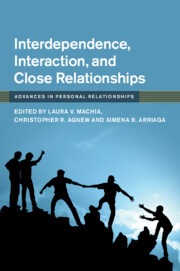Book contents
- Interdependence, Interaction, and Close Relationships
- Advances in Personal Relationships
- Interdependence, Interaction, and Close Relationships
- Copyright page
- Contents
- Figures
- Tables
- Contributors
- Acknowledgments
- Introduction
- Part I Interdependence, Situations, and Context
- Part II Interdependence, Security, and Risk
- Part III Interdependence, Goal Pursuit, and Person Factors
- 9 Autonomous Interdependence
- 10 Pursuing Interpersonal Value
- 11 Advances in Self-Expansion
- 12 Self-Esteem, Negative Expressivity, and Partner Responsiveness
- Part IV Interdependence, Timing, and Expectations
- Index
- References
9 - Autonomous Interdependence
A Complementary Understanding of Personal and Relational Needs in Interdependent Relationships
from Part III - Interdependence, Goal Pursuit, and Person Factors
Published online by Cambridge University Press: 19 June 2020
- Interdependence, Interaction, and Close Relationships
- Advances in Personal Relationships
- Interdependence, Interaction, and Close Relationships
- Copyright page
- Contents
- Figures
- Tables
- Contributors
- Acknowledgments
- Introduction
- Part I Interdependence, Situations, and Context
- Part II Interdependence, Security, and Risk
- Part III Interdependence, Goal Pursuit, and Person Factors
- 9 Autonomous Interdependence
- 10 Pursuing Interpersonal Value
- 11 Advances in Self-Expansion
- 12 Self-Esteem, Negative Expressivity, and Partner Responsiveness
- Part IV Interdependence, Timing, and Expectations
- Index
- References
Summary
Interdependent relationships are complex because they require the coordination of personal needs with relational needs. A common assumption in the extant literature is that personal needs are divergent from relational needs, requiring individuals to balance personal and relational needs by prioritizing one over the other at any given point. In the first section of this chapter, we draw on self-determination and interdependence theories to review existing research that challenges the assumption that personal and relational needs are inherently in conflict. We propose that personal and relational needs can be conceptualized as complementary, and that pursuing relational needs and goals does not necessarily involve sacrificing or deprioritizing personal ones (or vice versa). Instead, the pursuit of favorable personal and relational needs can serve to facilitate each other. Of course, relationship circumstances do not always allow for such complementary processes. Thus, the second section of this chapter overviews various conditions (e.g., relationship processes, relationship contexts, and individual differences) that pit personal and relational needs against each other, and explores how people adapt to and manage such circumstances. Taken together, this chapter aims to shed light on the complexities of coordinating personal and relational needs in highly interdependent relationships.
Keywords
Information
- Type
- Chapter
- Information
- Interdependence, Interaction, and Close Relationships , pp. 183 - 203Publisher: Cambridge University PressPrint publication year: 2020
References
Accessibility standard: Unknown
Why this information is here
This section outlines the accessibility features of this content - including support for screen readers, full keyboard navigation and high-contrast display options. This may not be relevant for you.Accessibility Information
- 4
- Cited by
